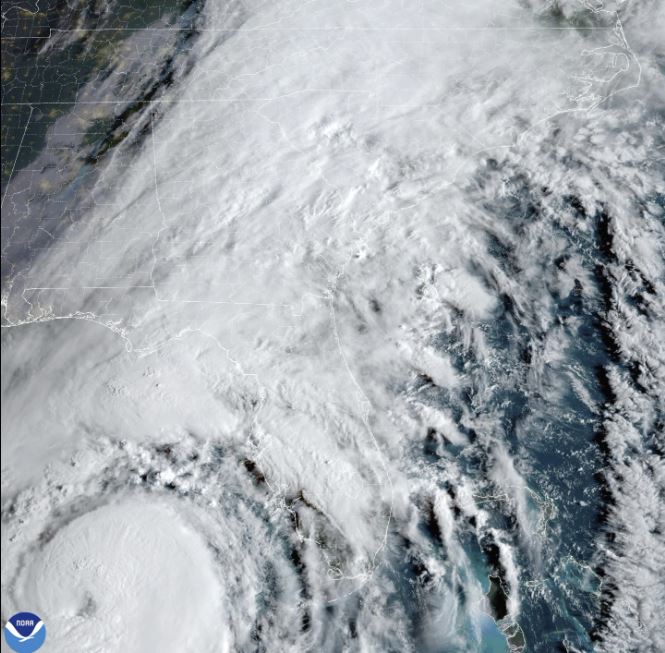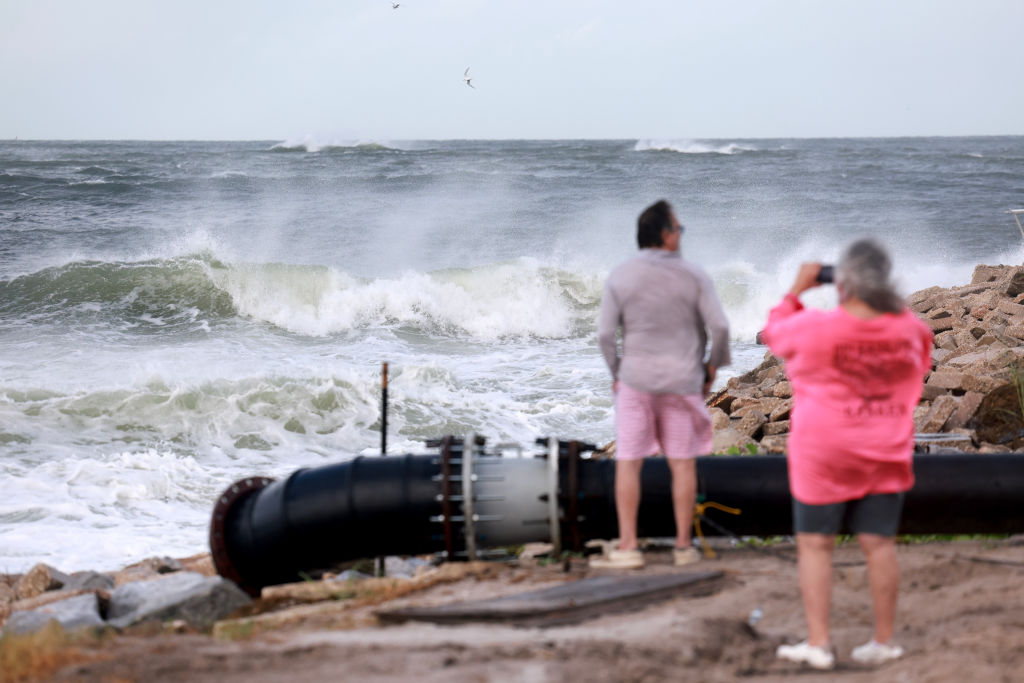Tropical storm force winds began battering Florida on Thursday as Hurricane Helene prepared to make landfall, with forecasters warning that the enormous storm could create a “nightmare” surge along the coast and churn up damaging winds hundreds of miles inland across much of the southeastern U.S.

Helene strengthened to a major Category 4 storm ahead of its evening landfall on Florida’s northwestern coast. Hurricane and flash flood warnings extend far beyond the coast up into northern Georgia and western North Carolina.
Category 4 hurricanes have sustained winds over 130 mph (209 kmh) that can severely damage homes, snap trees and down power lines. Strong winds have already cut power to over 250,000 homes and businesses in Florida, according to the tracking site poweroutage.us.
The hurricane was about 120 miles (195 kilometers) west of Tampa and had sustained winds of 130 mph (215 kph), according to the U.S. National Hurricane Center. Life-threatening storm surges of up to 20 feet (6 meters) were expected in the Big Bend area of Florida.
The storm’s wrath was starting to be felt Thursday afternoon, with water lapping over a road on the northern tip of Siesta Key near Sarasota and covering some intersections in St. Pete Beach along Florida’s Gulf Coast. Lumber and other debris from a fire in Cedar Key a week ago was crashing ashore in the rising water.
Hurricane warnings and flash flood warnings extended far beyond the coast up into northern Georgia and western North Carolina. The governors of Florida, Georgia, the Carolinas and Virginia have all declared emergencies in their states, as did President Joe Biden for several of the states. He is sending the head of the Federal Emergency Management Agency to Florida on Friday to view the damage.
Florida Gov. Ron DeSantis said Thursday morning that models suggest Helene will make landfall further east than earlier forecast, lessening the chances for a direct hit on the capital city of Tallahassee, whose metro area has a population of around 395,000.
The shift has the storm aimed squarely at the sparsely-populated Big Bend area, home to fishing villages and vacation hideaways where Florida’s Panhandle and peninsula meet.

“Please write your name, birthday, and important information on your arm or leg in a PERMANENT MARKER so that you can be identified and family notified,” the sheriff’s office in mostly rural Taylor County warned those who chose not to evacuate in a Facebook post, the dire advice similar to what other officials have dolled out during past hurricanes.
Still, Philip Tooke, a commercial fisherman who took over the business his father founded near the region’s Apalachee Bay, plans to ride out this storm like he did during Hurricane Michael and the others – on his boat. “If I lose that, I don’t have anything.”

Get daily National news
Many, though, were heeding the mandatory evacuation orders that stretched from the Panhandle south along the Gulf Coast in low-lying areas around Tallahassee, Gainesville, Cedar Key, Lake City, Tampa and Sarasota.
Among them was Sharonda Davis, one of several gathered at a Tallahassee shelter worried their mobile homes wouldn’t withstand the winds. She said the hurricane’s size is “scarier than anything because it’s the aftermath that we’re going to have to face.”
Federal authorities were staging search-and-rescue teams as the National Weather Service office in Tallahassee forecast storm surges of up to 20 feet (6 meters) and warned they could be particularly “catastrophic and unsurvivable” in Apalachee Bay.
“Please, please, please take any evacuation orders seriously!” the office said, describing the surge scenario as “a nightmare.”
This stretch of Florida known as the Forgotten Coast has been largely spared by the widespread condo development and commercialization that dominates so many of Florida’s beach communities. The region is loved for its natural wonders — the vast stretches of salt marshes, tidal pools and barrier islands.
“You live down here, you run the risk of losing everything to a bad storm,” said Anthony Godwin, 20, who lives about a half-mile (800 meters) from the water in the coastal town of Panacea, as he stopped for gas before heading west toward his sister’s house in Pensacola.
Along Florida’s Gulf Coast, school districts and multiple universities canceled classes. Airports in Tampa, Tallahassee and Clearwater were closed Thursday, while cancellations were widespread elsewhere in the state and beyond.
Helene was about 130 miles (205 kilometers) southwest of Tampa early Thursday evening and moving north-northeast at 23 mph (37 kph) with top sustained winds of at least 125 mph (205 kph).
While Helene will likely weaken as it moves inland, damaging winds and heavy rain were expected to extend to the southern Appalachian Mountains, where landslides were possible, forecasters said. The center warned that much of the region could experience prolonged power outages and flooding. Tennessee was among the states expected to get drenched.
Helene had swamped parts of Mexico’s Yucatan Peninsula on Wednesday, flooding streets and toppling trees as it passed offshore and brushed the resort city of Cancun. In western Cuba, Helene knocked out power to more than 200,000 homes and businesses as it brushed past the island.
Helene is forecast to be one of the largest storms in breadth in years to hit the region, said Colorado State University hurricane researcher Phil Klotzbach. He said since 1988, only three Gulf hurricanes were bigger than Helene’s predicted size: 2017’s Irma, 2005’s Wilma and 1995’s Opal.
Areas 100 miles (160 kilometers) north of the Georgia-Florida line can expect hurricane conditions. More than half of Georgia’s public school districts and several universities canceled classes. The state has opened its parks to evacuees, and their pets, including horses. And overnight curfews were imposed in many cities and counties in south Georgia, including Albany, Valdosta and Thomasville.
“This is one of the biggest storms we’ve ever had,” said Georgia Gov. Brian Kemp, who has authorized up to 500 National Guard soldiers.
For Atlanta, Helene could be the worst strike on a major Southern inland city in 35 years, said University of Georgia meteorology professor Marshall Shepherd.
Helene is the eighth named storm of the Atlantic hurricane season, which began June 1. The National Oceanic and Atmospheric Administration has predicted an above-average Atlantic hurricane season this year because of record-warm ocean temperatures.
In further storm activity, Tropical Storm Isaac formed Wednesday in the Atlantic and was expected to strengthen as it moves eastward across the open ocean, possibly becoming a hurricane by the end of the week, forecasters said. Officials said its swells and winds could affect parts of Bermuda and eventually the Azores by the weekend.
In the Pacific, former Hurricane John reformed Wednesday as a tropical storm and strengthened Thursday morning back into a hurricane as it threatened areas of Mexico’s western coast with flash flooding and mudslides. Mexico President Andrés Manuel López Obrador raised John’s death toll to five Thursday as the communities along the country’s Pacific coast prepared for the storm to make a second landfall.
- Most Canadians now want early election as Trudeau support drops again: poll
- NDP will vote to topple Trudeau and propose confidence vote, Singh says
- This Canadian is his school’s first medical student in a wheelchair. He’s thinking big
- Can Canada avoid Trump tariffs? Likely some, but not all: ex-envoy















Comments